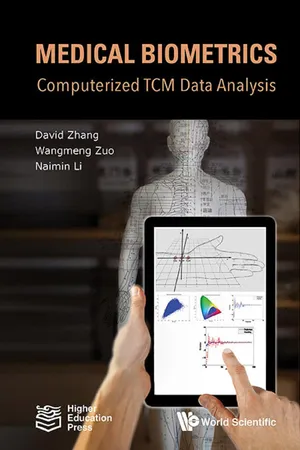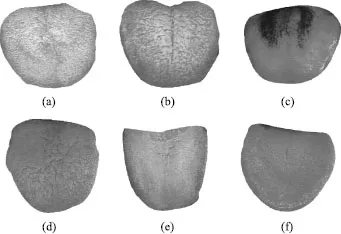![]() PART I: DIAGNOSIS METHODS IN
PART I: DIAGNOSIS METHODS IN
TRADITIONAL CHINESE MEDICINE![]()
Chapter 1Introduction
Diagnosis methods played an indispensable role in traditional Chinese medicine (TCM) for thousands of years. Generally, there are four categories of Chinese diagnosis methods: observation (‘to look’), auscultation (‘to smell and to hear’), interrogation (‘to ask’), and palpation (‘to touch’). Among these four categories, observation, auscultation, and palpation are relatively easier to be quantitatively acquired and objectively analyzed. In this chapter, we first introduce one observation (‘tongue diagnosis’), one auscultation (‘breath odor diagnosis’), and one palpation (‘pulse diagnosis’) method. Then, for the computational perspective, we provide the brief surveys on the progress of three computerized TCM diagnosis methods: computerized tongue diagnosis, computerized pulse diagnosis, and computerized breath odor diagnosis.
1.1Diagnosis Methods in Traditional Chinese Medicine
In traditional Chinese medicine, there are four major categories of diagnosis methods, i.e., observation (‘to look’), auscultation (‘to smell and to hear’), interrogation (‘to ask’), and palpation (‘to touch’). The most common observation, auscultation and palpation methods are tongue diagnosis, breath odor diagnosis and pulse diagnosis. Here we introduce these three diagnosis methods in TCM respectively.
1.1.1Tongue Diagnosis
Tongue diagnosis, i.e., inspection of the tongue [1–3], is one of the most important diagnostic methods of TCM, which is used to observe the abnormal changes in the tongue (also the body of the tongue or substance of the tongue) and the coating of the tongue in making diagnosis of disease. The tongue diagnosis has been widely applied to clinical analysis and applications in TCM for thousands of years. The simplicity, inexpensiveness, and noninvasiveness of tongue diagnosis make it very competitive in the development of remote diagnosis. Whenever there is a complex disorder full of contradictions, examination of the tongue can instantly clarify the main pathological processes. Many Chinese medicine doctors utilize the features of the tongue such as color, texture, and coating to differentiate syndromes and diagnose diseases, e.g., intestinal infarction, cholecystitis, appendicitis and pancreatitis.
Various kinds of tongue traits, including tongue’s color, texture, and the geometrical shape [4], have been inspected and analyzed by TCM doctors for retrieving significant pathological information of human body. Among all kinds of extracted medical information, tongue’s chromatic features play a vital part in evaluating a patient’s condition. Colors of substance and coating, which are two essential parts on the surface of a tongue, are major cues for TCM practitioners to make a diagnostic decision. Fig. 1.1 presents several typical images with various types of chromatic features. Color patterns inspected from them may lead to distinct diagnostic results. In addition, various types of tongue texture style also provide plenty of valuable information for diagnosis. Fig. 1.2 shows three typical tongue texture styles: tongue fissure, tongue crack and red point. Different texture styles convey various pathological information of internal organs, such as red point is usually found on the subject’s tongue with appendicitis.
However, traditional tongue diagnosis has its inevitable limitations. First, the clinical competence of tongue diagnosis is determined by the experience and knowledge of the physicians. Second, environmental factors, such as differences in light sources and brightness, have a great influence on the physicians in obtaining good diagnostic results from the tongue. Finally, traditional tongue diagnosis is intimately related to the identification of syndromes, and it is not very well understood by Western medicine and modern biomedicine. Therefore, it is necessary to build an objective and quantitative diagnostic standard for tongue diagnosis.
1.1.2Pulse Diagnosis
For thousands of years, pulse diagnosis is a convenient, noninvasive, and effective diagnostic method that has been widely and successfully used in TCM [5–13]. In traditional pulse diagnosis, practitioners put three fingers on the three positions, i.e., Cun, Guan, and Chi, on the wrist of the patient to feel the pulse beating of the radial artery as shown in Fig. 1.3. Since the wrist pulse signals contain vital information and can reflect the pathological changes of a person’s body condition, the practitioners can then determine the person’s health conditions from the pulse signal.
Modern clinical studies demonstrate that there is premature loss of arterial elasticity and endothelial function for patients with certain diseases, such as hypertension, hypercholesterolemia and diabetes. Such loss will eventually decrease the flexibility of vasculature, whilst increase the stress to the circulatory system. As a result, the shape, amplitude and rhythm of patient wrist pulses will also alter in correspondence with the hemodynamic characteristics of blood flow.
Traditional pulse diagnosis requires considerable training and experience, and may produce significant variations in diagnosis results for different practitioners [8, 11]. So in recent years techniques developed for measuring, processing, and analyzing the physiological signals have been considered in quantitative pulse diagnosis research as a way to improve the reliability and consistency of diagnoses.
1.1.3Breath Odor Diagnosis
Breath analysis is the examination of breath for the presence of certain compounds to determine the presence of some diseases and conditions in the human body. Endogenous molecules in exhaled breath, such as acetone, nitric oxide, hydrogen, and ammonia, are produced by metabolic processes. They are separated from blood and enter into the alveolar air via the alveolar pulmonary membrane. Variations in the concentration of these molecules can suggest various diseases or at least changes in metabolism. For instance, nitric oxide in breath can be measured as an indicator of asthma or other conditions characterized by airway inflammation. Increased pentane and carbon disulfide have been observed in the breath of patients with schizophrenia. Breath concentration of volatile organic compounds (VOCs) such as cyclododecatriene, benzoic acid, and benzene are much higher in lung cancer patients than in control groups [14, 15]. Acetone has been found to be more abundant in the breath of diabetics [16, 17], and breath ammonia is significantly elevated in patients with renal diseases [18]. These molecules are considered as biomarkers of the presence of diseases and clinical conditions. Much can be learnt from them about the overall state of an individual’s metabolism or physical condition.
Breath analysis has many advantages compared with other traditional methods such as blood and urine tests [19]. Firstly, breath analysis is a noninvasive method, and it causes the least harm to both the subjects and the personnel who collect the samples. Secondly, the results can be obtained immediately, and thirdly, the sample collection is quite easy for a subject, since the only requirement to collect a breath sample is that the subject must be breathing. Therefore, increasing interest has been expressed about the applications of breath analysis in medicine and clinical pathology, both as a diagnostic tool and as a way to monitor the progress of therapies [20, 21].
The exploitation of ‘metabolic profile’ strictly associates with the reliable ways of accessing it and the suitable instruments used to perfor...



